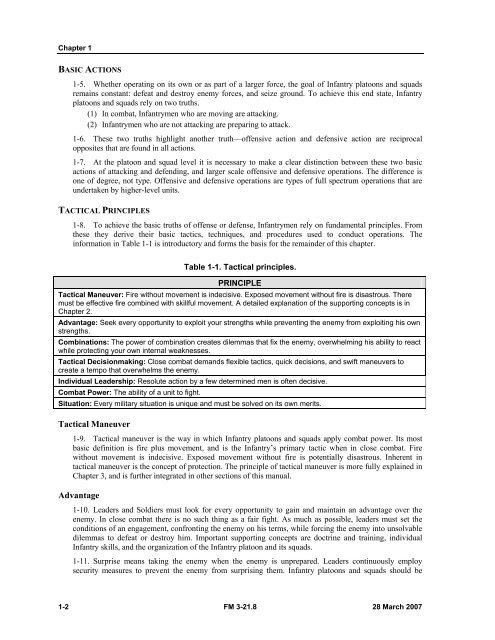Infantry Rifle Platoon and Squad - Sakai
Infantry Rifle Platoon and Squad - Sakai
Infantry Rifle Platoon and Squad - Sakai
Create successful ePaper yourself
Turn your PDF publications into a flip-book with our unique Google optimized e-Paper software.
Chapter 1<br />
BASIC ACTIONS<br />
1-5. Whether operating on its own or as part of a larger force, the goal of <strong>Infantry</strong> platoons <strong>and</strong> squads<br />
remains constant: defeat <strong>and</strong> destroy enemy forces, <strong>and</strong> seize ground. To achieve this end state, <strong>Infantry</strong><br />
platoons <strong>and</strong> squads rely on two truths.<br />
(1) In combat, <strong>Infantry</strong>men who are moving are attacking.<br />
(2) <strong>Infantry</strong>men who are not attacking are preparing to attack.<br />
1-6. These two truths highlight another truth—offensive action <strong>and</strong> defensive action are reciprocal<br />
opposites that are found in all actions.<br />
1-7. At the platoon <strong>and</strong> squad level it is necessary to make a clear distinction between these two basic<br />
actions of attacking <strong>and</strong> defending, <strong>and</strong> larger scale offensive <strong>and</strong> defensive operations. The difference is<br />
one of degree, not type. Offensive <strong>and</strong> defensive operations are types of full spectrum operations that are<br />
undertaken by higher-level units.<br />
TACTICAL PRINCIPLES<br />
1-8. To achieve the basic truths of offense or defense, <strong>Infantry</strong>men rely on fundamental principles. From<br />
these they derive their basic tactics, techniques, <strong>and</strong> procedures used to conduct operations. The<br />
information in Table 1-1 is introductory <strong>and</strong> forms the basis for the remainder of this chapter.<br />
Table 1-1. Tactical principles.<br />
PRINCIPLE<br />
Tactical Maneuver: Fire without movement is indecisive. Exposed movement without fire is disastrous. There<br />
must be effective fire combined with skillful movement. A detailed explanation of the supporting concepts is in<br />
Chapter 2.<br />
Advantage: Seek every opportunity to exploit your strengths while preventing the enemy from exploiting his own<br />
strengths.<br />
Combinations: The power of combination creates dilemmas that fix the enemy, overwhelming his ability to react<br />
while protecting your own internal weaknesses.<br />
Tactical Decisionmaking: Close combat dem<strong>and</strong>s flexible tactics, quick decisions, <strong>and</strong> swift maneuvers to<br />
create a tempo that overwhelms the enemy.<br />
Individual Leadership: Resolute action by a few determined men is often decisive.<br />
Combat Power: The ability of a unit to fight.<br />
Situation: Every military situation is unique <strong>and</strong> must be solved on its own merits.<br />
Tactical Maneuver<br />
1-9. Tactical maneuver is the way in which <strong>Infantry</strong> platoons <strong>and</strong> squads apply combat power. Its most<br />
basic definition is fire plus movement, <strong>and</strong> is the <strong>Infantry</strong>’s primary tactic when in close combat. Fire<br />
without movement is indecisive. Exposed movement without fire is potentially disastrous. Inherent in<br />
tactical maneuver is the concept of protection. The principle of tactical maneuver is more fully explained in<br />
Chapter 3, <strong>and</strong> is further integrated in other sections of this manual.<br />
Advantage<br />
1-10. Leaders <strong>and</strong> Soldiers must look for every opportunity to gain <strong>and</strong> maintain an advantage over the<br />
enemy. In close combat there is no such thing as a fair fight. As much as possible, leaders must set the<br />
conditions of an engagement, confronting the enemy on his terms, while forcing the enemy into unsolvable<br />
dilemmas to defeat or destroy him. Important supporting concepts are doctrine <strong>and</strong> training, individual<br />
<strong>Infantry</strong> skills, <strong>and</strong> the organization of the <strong>Infantry</strong> platoon <strong>and</strong> its squads.<br />
1-11. Surprise means taking the enemy when the enemy is unprepared. Leaders continuously employ<br />
security measures to prevent the enemy from surprising them. <strong>Infantry</strong> platoons <strong>and</strong> squads should be<br />
1-2 FM 3-21.8 28 March 2007

















